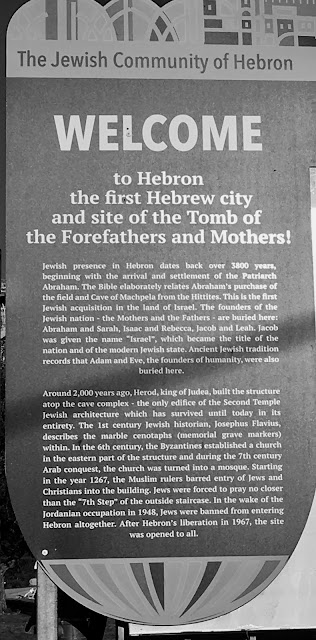Last month, on a sunny day, Sten and I decided to visit Bethlehem. It's been quite a few years since we've been there, so we weren't sure what to expect. We took the public bus the approximately 6 miles to the town. Bethlehem's population is approximately 50% Christian Palestinians, and 50% Muslim Palestinians.
Because it is considered the traditional birthplace of Jesus, Bethlehem's major economy is based around tourism by Christian pilgrims. We were surprised that we had to wait in line to get into the Church of the Nativity, which is at one side of Manger Square in the center of the old town area.
It's a rather humble-looking building and entrance from the outside. Commissioned in 327 A.D. by Constantine the Great and his mother Helena, it is the oldest site continuously used as a place of worship in Christianity, and the oldest major church in the Holy Land. It was destroyed by fire in the 6th century and rebuilt by the Byzantine Emperor Justinian, who restored the original tone of the structure. The main basilica is maintained by the Greek Orthodox.
The doorway into the church -- known as the Door of Humility -- is very low. I am about 5 feet 2 inches, so you can see it's clearly not much higher than 4 feet.
The first photo is taken looking towards the front altar of the church. The people lined up are waiting to go down into the Grotto of the Nativity, the space under the main altar of the church where Jesus was born, according to tradition.
On the left in the following photo is the small entrance to the stairs going down to the Grotto. The second photo was taken by Sten of me just as I'm about to pass through the doorway.
The Grotto contains the Altar of the Nativity which has a 14-pointed star set in marble marking the place of the birth. Surrounding the star are 15 silver lamps, representing the Greek Orthodox, Roman Catholic, and Armenian Apostolic Christian communities. Also in this cave are Grotto of the Manger and the Altar of the Magi, each maintained by different religious groups that have a stake in this site. Each of these places are revered by pilgrims who often bend down and kiss the spot.
The next photo is looking back at the Grotto from the stairs on the other side which are for exiting the area.
This view of Bethlehem is from a spot near the Church of the Nativity and Manger Square.
While eating lunch in Bethlehem, we got to talking to the owner of the restaurant. I happened to mention wanting to visit Hebron, and the Tomb of the Patriarchs (also called the Cave of Machpelah), which I had visited many years ago. Sten had never been there, and we weren't sure exactly how far it was from Bethlehem. He told us it was about 12 miles south and said he could get us a driver with a car to get there. We agreed on a price, and off we went.
We decided to climb the steps to the Jewish synagogue. An armed guard asked us what religion we are. When we said "Christian," he let us enter, though we were told we could take no photos as it was Shabbat (Sabbath). Going to the mosque, we again were asked by an armed guard what religion we are. When we again said "Christian," we again were permitted to enter, though this time with no restriction on photo-taking. We climbed up the long flight of stairs to the mosque.
Before entering a mosque, we did have to remove our shoes, as is usual , and I had to don a hooded robe. As you can see, the place had very few visitors while we were there, and tourists were almost nonexistent.
Inside the beautifully carpeted mosque, we saw the cenotaphs of various patriarchs -- empty memorials to those buried in the crypt in the cave below. Unfortunately, no signs in any language we could read, identify who is remembered where. Also, the memorials are inside barred structures, so the photos had to be taken through those.
Here's the "minbar" or pulpit for the imam to read and speak from.
Hebron is also known for its blown glass and painted pottery. Very close to the tomb was this glass blower's workshop and store.
And here's where the magic happens.
I'll end with this sign I saw the other day in the Old City of Jerusalem.
Peace, Salam, and Shalom.





































No comments:
Post a Comment